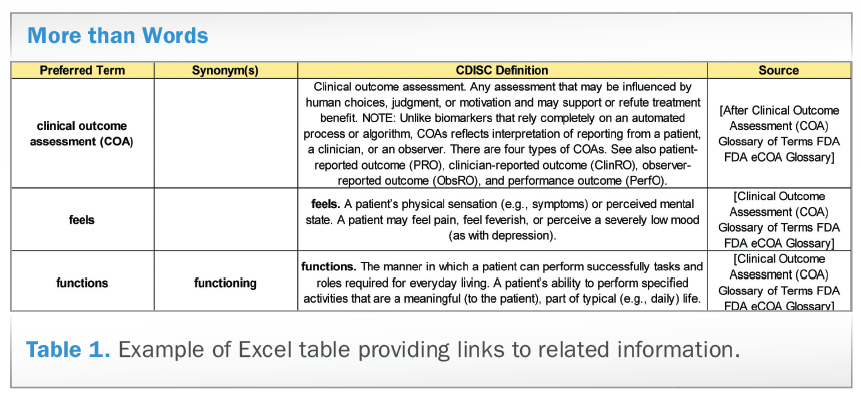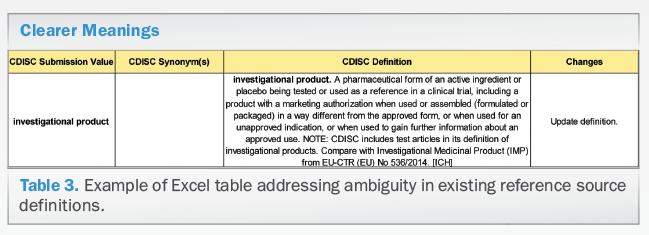CDISC Glossary of Clinical Research Terminology
Applied Clinical Trials
Reference tool is a Rosetta Stone for clinical research. A look at the updates and enhancements in latest version.
The world of clinical research includes participants from many sectors: the pharmaceutical industry, government agencies, academia, healthcare providers, subjects, patients, technology providers, and many others. While there may be the perception that a lingua franca has evolved through common usage, this is not the case. We may find ourselves using common terminology, yet the strict definitions and interpretations of these words often differ markedly. This is not due solely to differences in native language or culture, but to the multiple “authoritative sources” of clinical research applicable definitions, including FDA, EMA, ICH, WHO, International Organization for Standardization (ISO), and specialty groups that code and use terminology for healthcare, payers, hospitals, and other stakeholders. While, in principle, the Glossary addresses global use, the primary sources of definitions are based on those derived from U.S. and European standards organizations and regulatory authorities.
Add to this scenario the need to ensure that information provided is both human- and machine-readable-a concept called “interoperability.” This really was the genesis point for CDISC-evolving, of necessity, as a standards organization at the beginning of the age of electronic data collection, analysis, and submission to regulatory authorities in support of new drug applications for marketing approval.
The long-standing Mission Statement for CDISC’s Glossary Group-the longest-serving working group under the CDISC umbrella (convening for the first time in 2002)-echoes these origins:
CDISC Glossary seeks to harmonize definitions (including acronyms, abbreviations, and initials) used in the various standards initiatives undertaken by CDISC in clinical research. Glossary also serves the community of clinical researchers by selecting and defining terms pertaining to clinical research, particularly eClinical investigations, sponsored by the pharmaceutical industry or a federal agency.
Recently, it has become apparent that the clarity and comprehension provided by the Glossary supports colocation and translation of the concepts in the many countries where research is done, and the resulting products are used.
Thus, the Glossary is intended to serve both novice and experienced users as an authoritative advisory resource in the context of clinical research and development. To accomplish this, it was necessary to identify recognized sources of definitions, clarify differing contextual interpretations, and, as much as possible, harmonize across a global landscape of word usage. It should be emphasized that the Glossary Group is not a standards development body but, rather, one that has developed an aid to better understanding the terminology.
Occasionally, the members of the group made modifications to definitions in order to better represent the most common use or, when no authoritative source was identified, defined the term, based on their extensive collective experience in the conduct of clinical studies; collection, analysis, and interpretation of data derived from those studies; and long-standing roles in the development of CDISC models for protocols, data standards, and collaboration with regulatory authorities worldwide.
The CDISC Glossary Version 11.0 adds to the four groups of new terms included in last year’s update: Milestones, eSource, Transparency, and Clinical Trial & Clinical Study. This year’s Glossary expands the Outcomes Assessment (and eCOA) and endpoints; and includes some new terms from ISO for the identification of medicinal products (IDMP), the ICH E6 update, and elements from the Common Protocol. The NIH-FDA BEST (Biomarkers, Endpoints, and other Tools) Resource, which contains FDA-NIH harmonized terms used in translational science, is included the Glossary’s Reference Citations section. Specific terms are included in this year’s update.
An additional technical update made this year is that the CDISC glossary content will be integrated into the NCI Thesaurus (NCIt; ncit.nci.nih.gov), an open source, publicly available biomedical coding terminology developed by the U.S. National Cancer Institute’s Enterprise vocabulary services (NCI-EVS).
Examples of operational issues addressed in the course of the Glossary development include:
• Providing useful resources beyond the term definition. Although the focus of the Glossary is to define commonly-used terms, the group determined that there would be great added value in providing links to associated information. These allow the user to further explore context and nuance that cannot be accommodated in the Glossary itself. Table 1 shows an example of the Excel table.
Click to enlarge

• Multiple interpretations. On occasion, there were multiple legitimate definitions that needed to be considered. These definitions usually differed due to associated context. Thus, in order to recognize this, we provided these definitions with explanatory notes that conveyed the rationale and appropriate use. Older versions of the Glossary were organized like a dictionary of terms, without supporting the sorting and searching utilities that enhance review of a tabular format. This year, for the first time, the Glossary and its many formats can be filtered and the terms are unique (see Table 2). Each unique term has a single definition and synonyms, or similar terms, are noted.
Click to enlarge

• Enhanced functionality. Adding this new and long-awaited feature to enable easier searching and readability, the Glossary has been updated to a PDF-based tabular format with searchable functionality. Terms can be sorted and filtered. Thus, it is truly sortable, linkable, and serviceable as a “go-to” reference tool. This version is remarkable in that it will be available in six different formats and more suited for digital download and use. These are Excel, Windows text file (.txt), odm.xml, pdf, html, and OWL/RDF formats.
• Term selection and organization. Terms were carefully selected to ensure that they were germane to clinical R&D. We provide definitions that are, hopefully, sufficient to gain a basic understanding of the term and context. As noted earlier, the links to the source(s) are provided should the user wish to go into more depth. Terms are co-located and electronic searching is augmented by “child-parent” term organization.
• Historical ambiguity. Some terms carry with them long-standing confusion among users. We have addressed, as much as possible, ambiguity in existing reference source definitions and provided clarification. Some examples are the often synonymous but confusing use of “dose” and “dosage”, as well as “study” and “trial.” An example of the Excel table is shown in Table 3.
Click to enlarge

• Acronyms, abbreviations, and initials. Links will also be provided in the Glossary to access acronyms, abbreviations, and initials. The Acronyms, Abbreviations and Initials list was not comprehensively updated during the Glossary update cycle for Version 11.0.
The future: Watch this space
Next year, the CDISC Glossary Group will continue to address concepts introduced and presented in new guidelines. As technology and globalization continue to evolve, we will be taking on the impact of guidances like the EU Clinical Trials Regulation (CTR) that goes into effect when the European database is operational. We will also continue to address concepts around transparency and disclosure as the pharmaceutical industry and regulators wrestle with the pragmatic logistics of providing timely and useful information to the research community, while protecting patient privacy.
We test links to sources for individual terms and, while not all terms are updated each year, we will reassess terms periodically to ensure currency. Although the Glossary is now available in six formats, we will be exploring how to optimize it for use on handheld devices.
Where to find the CDISC Glossary
- Authors of this report and Glossary Team members: Art Gertel, Principal, MedSciCom, LLC; Helle Gawrylewski (Team Chair), MA, Sr. Director, Janssen R&D Companies of J&J; Steve Raymond, PhD, Chief Scientist, Scientific Affairs, ERT; Erin Muhlbradt, PhD, Clinical/Biomedical Information Specialist, Enterprise Vocabulary Services, National Cancer Institute
Contributors/Glossary Team members: Denise Adelman, Global Process, Senior Analyst, J&J; Guido Claes, Director, Master Data Standards, Global Clinical Development Operations, Janssen R&D Companies; Melissa Cook, Senior Management Consultant, MC Consulting; Jon Hilton, Global Data Standards Manager, F. Hoffmann-La Roche Ltd
We would also like to acknowledge the assistance of CDISC staff and SIRO Clinpharm

Clinical Trial Results Show Krystexxa Reduced Blood Pressure in Adults With Chronic Gout
November 6th 2023Pegloticase (Krystexxa; Amgen) is approved to treat chronic gout in adults who fail to normalize serum uric acid and whose signs and symptoms are inadequately controlled with xanthine oxidase inhibitors.